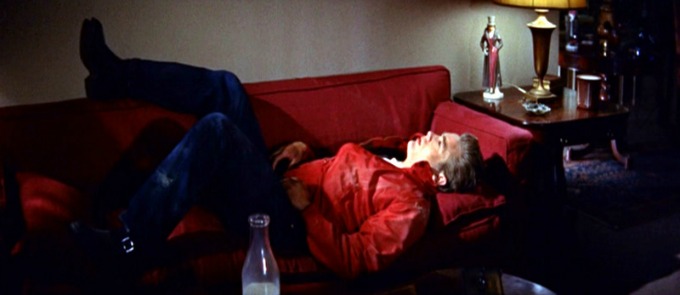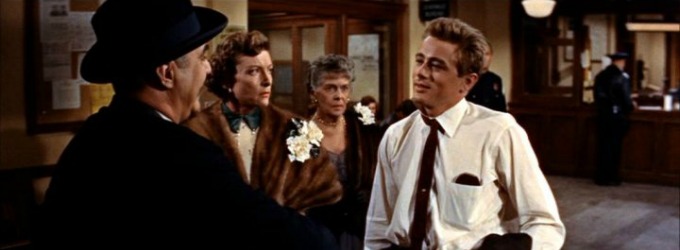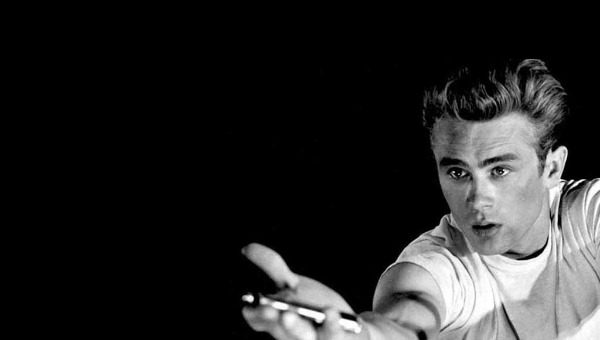 Nineteen fifty-five was a pivotal year for North American baby boomers growing up in the suburban wastelands. Those who were fortunate enough to be born in the sweet spot, the late 1940s immediately following the Second World War, were not yet teenagers. In that year, however, a series of seismic cultural events occurred that would come to define their flower-power generation.
Nineteen fifty-five was a pivotal year for North American baby boomers growing up in the suburban wastelands. Those who were fortunate enough to be born in the sweet spot, the late 1940s immediately following the Second World War, were not yet teenagers. In that year, however, a series of seismic cultural events occurred that would come to define their flower-power generation.
“Hey Johnny, what are you rebelling against?” … “Whaddyagot?”
Elvis Presley made his first national appearance on the television version of Louisiana Hayride on March 3, 1955, and inspired a certain rebellious young man and aspiring artist growing up in Liverpool to pick up a guitar. BLACKBOARD JUNGLE was released that year, with its first use of a rock song to open a film, “Rock Around the Clock” by Bill Haley & His Comets, and THE WILD ONE with Marlon Brando had been released just months previous, in 1954. His jeans, white T and leather motorcycle jacket became the uniform of every teenage rebel ever since. It’s an immortal retort from that movie that defined the spirit of The Sixties: “Hey Johnny, what are you rebelling against?” “Whaddyagot?” Brando snarls. And, of course, October 1955 saw the release of what has become the iconic American film from the 1950s, REBEL WITHOUT A CAUSE, starring James Dean, Natalie Wood (Oscar nominee for best supporting actress) and Sal Mineo (nominee for best supporting actor), and directed by Nicolas Ray.
REBEL, BLACKBOARD JUNGLE and THE WILD ONE were part of a spat of juvenile delinquent films from the 50s, a list that includes such titles as TEENAGE BAD GIRL, YOUNG AND WILD, HIGH SCHOOL HELL CATS, TEENAGE DEVIL DOLLS and MOTORCYCLE GANG. REBEL WITHOUT A CAUSE, BLACKBOARD JUNGLE and THE WILD ONE might have been made with bigger budgets and featured more star power than their B-movie cousins, but they were made to appeal to the same burgeoning teenage market. Yet, since its release, REBEL has moved well beyond that core audience to become an enduring cinematic classic, an archetypal film of teenage angst and disillusionment not unrelated to Catcher in the Rye (published four years earlier); and the first film to explicitly spell out the looming “generation gap.” It was clearly a harbinger of things to come.
“He calls me a dirty tramp – my own father!”
We first see our trio of misfits in a late-night police station waiting area, each brought in for a minor offense. Shot in colour and CinemaScope, Ray’s use of extremely subjective point of view and wide camera angles obviate the subliminal emotions inherent in the scene. Jim (Dean) is in for public intoxication and loudly imitating a police siren. Judy (Wood) is a good girl going bad, upset that she’s no longer her daddy’s little girl (“He calls me a dirty tramp – my own father!” she blurts out to a sympathetic officer, played by Ray Fremick), and shy, friendless “Plato” (Mineo), who only has an African-American servant (Marietta Canty) for a guardian, is in for killing new-born puppies. (“They were nursing on their mother and I did it I guess. I’m just no good.”) Over the next 24 hours, the lives of these three will intersect in what is essentially an up-dated version of Romeo and Juliet (which, the director proclaimed, was the “best play written about juvenile delinquents”).
Jim struggles to make sense of his middle-class upbringing and the gnawing restlessness within his soul, made worse by an overbearing, castrating mother (Anne Doran) and mealy-mouthed, wishy-washy father (Jim Backus) both completely out of touch with his problems and concerns. As the new kid at the local high school, he is treated like a “disease”, and on a school trip to the Griffith Observatory in Los Angeles he’s challenged to a switchblade fight by Buzz (Corey Allen), the local gang leader, and a late-night “chickie run” where two drivers in auto-yard wrecks head at top speed toward a high cliff, and the first to bailout is the “chicken.”
Jim eventually finds kindred spirits in Judy and Plato, and over the course of the event-fuelled night the three form an unconventional “family” of their own. But their strong bond only temporarily brings them a few hours of peace, love and understanding before adult and outside forces come crashing down around their ears, tearing them apart in a tragic ending that nevertheless offers some hope for the future.
“never apologize son, it’s a sign of weakness”
REBEL captures both Dean’s astounding screen magnetism and tinderbox emotions, and one can’t separate the film from the legend that he would become upon his untimely death in a car crash just three weeks before the film opened. Dean skyrocketed to stardom at a very early age and joined the heady ranks of Marlon Brando, Warren Beatty and Montgomery Clift in defining a new masculinity on screen – men who cried and expressed their emotions openly. The transition of the male on-screen persona in American movies was tentatively shifting from the stoic image of a man of few words embodied by John “never apologize son, it’s a sign of weakness” Wayne and Gary Cooper (This transition would be complete with the next generation of male stars who replaced Dean, Brando and Clift: namely, the likes of Pacino, DeNiro, Hoffman and Nicholson.).
In the extended opening scene of REBEL, when Jim’s parents arrive at the police station and start dumping on each other about who’s to blame for their son’s troubles, Dean, in heartfelt anguish cries, “You’re tearing me apart! [to his mother] You say one thing, he says another, and everyone changes back again!”. Later, in perhaps one of the most famous scenes in the movie, Jim is arguing with his father about taking some responsibly for the death of Buzz that night in the chickie run, which went horribly wrong. His father has a tray in his hands and is wearing a frilly kitchen apron. His mother comes down the stairs and, standing over them, proclaims that the solution to the problem is not to go to the police but to move again. In tears, Jim pleads to his father, “Dad, stand up for me”. Backus remains silent, henpecked and defeated, as Dean runs out of the house; but not before he puts his foot through a portrait of his mother.

With his death at the age of 24, Dean’s promising career came to an abrupt end. Yet for a whole host of reasons, he has never really passed on and remains, like Marilyn Monroe, a symbol of the movies themselves. His defiant stance, cigarette in hand, thumb stuck in his belt, wearing the red windbreaker he wore throughout the movie, is as much an identifiable image as Marilyn with her skirt up around her waist, or Brando in his leather jacket and white T leaning over a motorcycle.
To add a touch of macabre to the reputation of the film, all three stars came to an untimely end. Several years later Natalie Wood would fall off the back of a yacht one night, supposedly pie-eyed drunk, and she drowned. The circumstances surrounding her death are shrouded in some mystery as her husband Robert Walker, friend Christopher Walken and the boat’s captain were not aware that she had fallen overboard. Sal Mineo’s demise was no less dramatic. One of Hollywood’s first openly gay actors, he was stabbed to death in 1976 outside his apartment in a random attack that had nothing to do with his homosexuality or fame.
James Dean’s tragic death solidified his lasting fame.
“Live fast, die young and have a good-looking corpse”: James Dean’s tragic death solidified his lasting fame. His new wealth as a movie star allowed him to indulge in his passion for speed. He raced the California circuits in a souped-up Triumph and Porsche Speedster before he bought a brand new Porsche 550 Spyder, which he was driving at the time of the accident on his way to a local meet. Driving too fast, he lost control and flipped several times while trying to avoid hitting an oncoming vehicle. Severely injured with a broken spine, he was pronounced D.O.A. at the hospital. His friend and movie stunt driver Bill Hickman was following Dean and arrived first at the scene (On a note of trivia, it’s Hickman who’s driving the black Dodge Charger chased by Steve McQueen’s Mustang in BULLITT’s most famous scene).
Director Nicholas Ray was one of Hollywood’s true rebels and a consummate cinematic artist, highly regarded by the French New Wave. He was a dynamic, socially conscious writer/director with a superb visual sense and a gift for attaining fluid motion on the screen. Nominated for an Oscar for his original story for REBEL, Ray’s early training as an architect is evident in his films through the effect of locale and environment on the relationships and lives of his characters. His heroes, frequently anguished social rebels, consume themselves in the quest of love or in fast and furious living.
In REBEL Ray presents in visual terms his theme that human relationships occur not against a background of abstract morality, but of physical uncertainty. He makes this clear in several sequences. The students in the Griffith Observatory make childish and silly jabs at one another until the explosion and death of Earth shuts them up and they cower, if only for a moment. The following scene shows Jim and Buzz fighting along a walkway overlooking Los Angeles from a great height. Jim forces Buzz over the ledge, foreshadowing the chickie-run where Buzz falls to his death. For Ray, all violent action takes place near some type of edge where there’s little solid support, moral otherwise, and where one may or may not fall over. No wonder the French love his films. (Other notable works by Ray to catch if you can are THEY LIVE BY NIGHT, IN A LONELY PLACE and JOHNNY GUITAR.)
No wonder the French love his films.
 The spot where the fight took place on the Observatory grounds is a magnet for James Dean fans, much like Graceland is for Elvis fans. If you walk around the back of the Observatory itself, you will come across the balcony overlooking L.A. from where the security guard calls down, breaking up the knife fight on the walkway below. A bust of Dean on a pedestal is prominently displayed on the path leading up to the grand main entrance.
The spot where the fight took place on the Observatory grounds is a magnet for James Dean fans, much like Graceland is for Elvis fans. If you walk around the back of the Observatory itself, you will come across the balcony overlooking L.A. from where the security guard calls down, breaking up the knife fight on the walkway below. A bust of Dean on a pedestal is prominently displayed on the path leading up to the grand main entrance.
Dean’s on-screen androgyny and (unsubstantiated) rumors of bisexuality made him an early icon of the gay movement. In his article “Dangerous Talents,” published in Vanity Fair in March 2005, Sam Kashner wrote that Ray, screenwriter Steward Stern, Dean and Mineo himself all intended for Mineo’s character Plato to be subtly but definitely understood as gay. Kashner says that although the Production Code was still very much in force and forbade any mention of homosexuality, Ray, Dean, Mineo and Stern all worked together to insert restrained references to Plato’s homosexuality and attraction to Jim, including the pinup photo of handsome actor Alan Ladd on Plato’s locker door, Plato’s longing looks at Jim, and even the name “Plato,” which is a reference to the classical Greek philosopher who was known to be a homosexual.
Finally, one last anecdote to complete this quick once-over on one of the most important Hollywood films from the 1950s. Natalie Wood wanted the part of Judy badly, and even though she was a rising star – and the two were having an affair –Ray felt her screen image was too “goodie-two-shoes” for the good girl/bad girl role he had in mind. Apparently he had a change of heart when she did what we today might call “doing a Bieber.” She was in a minor car accident with Dennis Hopper – who has a small part in the film as a member of Buzz’s gang – one night, and they had been drinking. The press reported that someone in the hospital called her a “goddamn juvenile delinquent.”
In 1990, REBEL WITHOUT A CAUSE was added to the preserved films of the United States Library of Congress’s National Film Registry as being deemed “culturally, historically and aesthetically significant.”
httpvh://youtu.be/wXRgAXU1-T4


One thought on “Rebel Without A Cause”
Comments are closed.